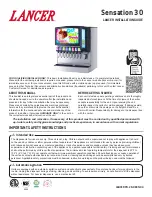
4
IMPORTANT SAFEGUARDS
!
General Installation Guidelines
This water softener's control valve conforms to UL/CE
Standards. Generic valves were tested and certified for
compliance as verified by the agency listing. This water
softening system is to be used only for potable water. Inspect
the water softening system for carrier shortage or shipping
damage before beginning installation.
Operating Perameters
• Operating ambient temperature: 40°F to 110°F (5°C to 43°C).
• Operating water temperature: 40°F to 110°F (5°C to 43°C).
• Operating water pressure range: 25 to 120 psi (1.7 to 8.27 bar).
Installation Perameters
All plumbing should be done in accordance with local plumbing
codes.
• Do not use pipe dope or other sealants on threads. Use PTFE
tape on the threaded inlet, outlet, and drain fittings. PTFE tape is
not necessary on the nut connection or caps because of O-ring
seals.
• All plastic connections should be hand tightened. PTFE tape may
be used on connections that do not use an O-ring seal. Do not
use pipe dope type sealants on the valve body.
Do not use pliers
or pipe wrenches, which can result in overtightening that
may impact the product's operation.
• Drain line requirements must be followed.
• Keep the cabinet tank in the upright position. Do not turn upside
down or drop. Turning the tank upside down or laying the tank on
its side can cause media to enter the valve.
• The pipe size for the drain line should be a minimum of ½".
Backwash flow rates in excess of 7 gpm (26.5 lpm) or length in
excess of 20’ (6.1m) require a ¾" drain line.
• Do not support the weight of the system on the control valve
fittings, plumbing, or the bypass.
Environmental
• Use only regenerants designed for water softening. Do not use ice
melting salt, block salt, or rock salt.
• During cold weather it is recommended that the installer warm the
valve to room temperature before operating.
• Do not use petroleum-based lubricants such as petroleum jelly,
oils, or hydrocarbon-based lubricants. Use only 100% silicone
lubricants.
• Do not allow this water softening system to freeze. Damage from
freezing voids the warranty of this water softening system.
• HYDROCARBONS SUCH AS KEROSENE, BENZENE, AND
GASOLINE MAY DAMAGE PRODUCTS THAT CONTAIN
O-RINGS OR PLASTIC COMPONENTS. EXPOSURE TO
SUCH HYDROCARBONS MAY CAUSE THE PRODUCTS
TO LEAK. DO NOT USE THE PRODUCT(S) LISTED IN
THIS DOCUMENT ON WATER SUPPLIES THAT CONTAIN
HYDROCARBONS SUCH AS KEROSENE, BENZENE, AND
GASOLINE.
• THIS WATER METER SHOULD NOT BE USED AS THE
PRIMARY MONITORING DEVICE FOR CRITICAL OR
HEALTH EFFECT APPLICATIONS.
Electrical
As with any electrical product, care should be taken to guard
against the potential risk of fire, electric shock, and injury to
persons.
• Use only the power transformer supplied with this water softening
system.
• All electrical connections must be completed according to local
codes.
• The power outlet must be grounded.
• All electrical connections must be connected according to local
codes. (Be certain the outlet is uninterrupted.)
• Install grounding strap on metal pipes.
• The power adapter comes with a 15-foot power cord and is
designed for use with the control valve. The power adapter
is for dry location use only.
The control valve remembers all
settings until the battery power is depleted if the power goes out.
• After the battery power is depleted, the only item that needs to be
reset is the time of day; other values are permanently stored in the
nonvolatile memory. The control valve battery is not rechargeable
but is replaceable.
• No user serviceable parts are on the PC board, the motor, or the
power adapter. The means of disconnection from the main power
supply is by unplugging the power adapter from the electrical
outlet.
• Install an appropriate grounding strap across the inlet and outlet
piping of the water softening system to ensure that a proper
ground is maintained.
• To disconnect power, unplug the AC adapter from its power
source.
Soldering
• Use only lead-free solder and flux, as required by federal and state
codes, when installing soldered copper plumbing.
• Use caution when installing soldered metal piping near the water
softening system. Heat can adversely affect the plastic control
valve and bypass valve.
• Solder joints near the drain must be done before connecting the
drain line flow control fitting. Leave at least 6" between the drain
line control fitting and solder joints when soldering pipes that are
connected on the drain line control fitting. Failure to do this could
cause interior damage to the drain line flow control fitting.
• When assembling the installation fitting package (inlet and outlet),
connect the fitting to the plumbing system first and then attach the
nut, split ring, and O-ring. Heat from soldering or solvent cements
may damage the nut, split ring, or O-ring. Solder joints should be
cool and solvent cements should be set before installing the nut,
split ring, and O-ring. Avoid getting primer and solvent cement on
any part of the O-rings, split rings, bypass valve, or control valve.





































